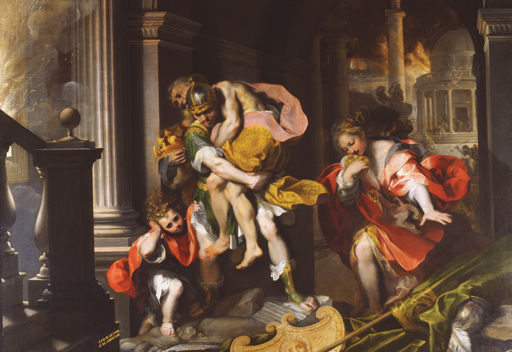3.3 Aeneas and pietas

One might expect that Aeneas, the man of destiny, embodies pietas and battles furor wherever he finds it, but Virgil is far too sophisticated a poet to present his story as a simple battle of good versus evil. Aeneas is in many ways an exemplar of pietas. He loves and respects his father Anchises, and is a devoted father to his young son Ascanius.
Activity 2
As Aeneas flees Troy in Book 2, Virgil describes him carrying his elderly father on his back while leading his son by the hand. Read Aeneas’ speech below, in which he gives instructions to his family on how to escape Troy, and note down the ways in which you think Aeneas demonstrates pietas here.
‘Come then, dear father, clasp my neck: I will
carry you on my shoulders: that task won’t weigh on me.
Whatever may happen, it will be for us both, the same shared risk,
and the same salvation. Let little Iulus come with me,
and let my wife follow our footsteps at a distance.
You servants, give your attention to what I’m saying.
At the entrance to the city there’s a mound, an ancient temple
of forsaken Ceres, and a venerable cypress nearby,
protected through the years by the reverence of our fathers:
let’s head to that one place by diverse paths.
You, father, take the sacred objects, and our country’s gods,
in your hands: until I’ve washed in running water,
it would be a sin for me, coming from such fighting
and recent slaughter, to touch them.’
Discussion
Aeneas’ love for his father comes through strongly in this passage, and the image of the three generations leaving Troy in this fashion became a famous symbol of pietas and family-mindedness. It was a popular theme in Roman art, and became a favourite subject for later European painters, as you can see from the image used to illustrate this section (Figure 4).
You might have also noticed that Aeneas does not forget the slaves of the household, for whose well-being he is responsible, and gives them instructions as to how to escape and where to meet. Aeneas’ pietas is also shown by his concern for the religious artefacts and statues of the household gods, which he instructs Anchises to carry with him. (In Figure 4 you can see them in Anchises’ right hand.) The gods are the symbol of the Trojan people, and must be kept safe until they can find a new home. Even in the midst of the chaos, Aeneas remembers to observe appropriate religious scruples. Because he is covered with blood, he might defile the holy objects by touching them before he can purify himself, so he makes sure that they are instead carried by Anchises, who as a non-combatant is religiously pure. However, Aeneas’ behaviour towards his wife is perhaps more troubling. Whereas he keeps his father and son close to him, he tells his wife to walk behind ‘at a distance’. Shortly afterwards we find out that Aeneas loses track of her, and that by the time he realises she is not with him, it is too late. Is this simply a tragic accident in the chaos of war, or is Aeneas to blame for what happens?
